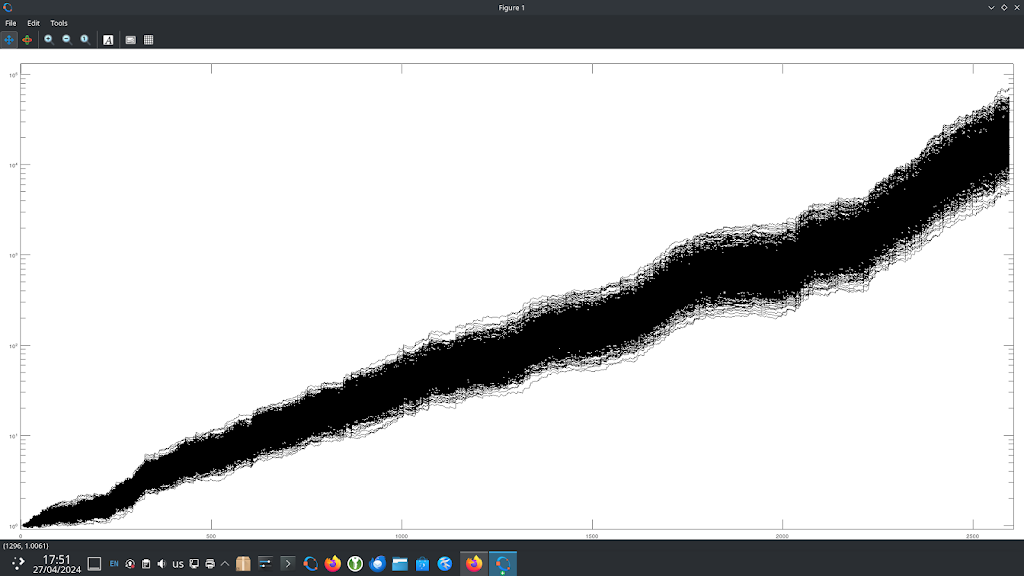My first test of trading forex news announcements is to test the efficacy of breakouts immediately following a news announcement related to the US dollar, specifically, only the high impact news as shown on the forexfactory calendar in red. The intention would be to capture some of the profit available from the big movements resulting from surprise news or simply market manipulation around these new events.
Rather than conduct a standard back test of a specific set of entry/exit rules to produce a single equity curve and test metrics, I decided to conduct a Monte Carlo simulation of R multiple returns, given that a news breakout occurred, across the following forex major pairs with USD as one of the pair, i.e. EUR-USD, GBY-USD, USD-CHF, USD-JPY, AUD-USD, NZD-USD and USD-CAD. I assumed that all the above pairs would collectively constitute one trade in the USD with a 1% risk in total, so each pair was allocated a 1/7th of 1% risk R multiple for each and every USD news announcement.
Whether a breakout occurred or not, the R multiple risk, and whether or not the trade would have been ultimately profitable was independently simulated thus for each of the above pairs:
- On the 10 minute OHLC bar close immediately prior to the time of the news announcement a simulated buy order and a sell order were placed a distance of 1x the close to close variance above and below the bar close, this variance being determined by the output of my kalman_ema function.
- The 1/7th of 1% risk R multiple was taken as the distance between these two entry orders, with each entry order having an attached protective stop-loss at the other entry order’s level.
- On the next 10 minute OHLC bar, assumed to be the bar that should show the reaction to the news, if neither of the entry orders are hit it is assumed that no trade would have taken place. This would be functionally equivalent to cancelling the entry orders 10 minutes after placing them if no news reaction in price occurs.
- If the next 10 minute bar hits both entry levels, it is assumed that a whipsaw trade would have occurred and this is booked as a -1R losing trade. In all the simulations that follow, this trade will always be a -1R loss.
- If neither of the conditions in 3 or 4 above are met, it follows that one of the entry levels would have been hit and not stopped out on the entry bar. In this case, the maximum favourable excursion (MFE) of the high (for long entries) or low (for short entries) over the next 24 10min OHLC bars (4 hours) is recorded in terms of its R multiple value.
- Simultaneously with 5 above, it is recorded whether or not at any time in this forward looking 24 bar period this trade’s entry protective stop level would have been breached.
- The simulation now starts: all -1R trades from step 4 are kept as -1R losing trades.
- All trades that are flagged as having hit the stop level from step 6 have a random 50% chance of being booked as a -1R loss. This simulates being stopped out before the MFE is reached, or alternatively, completely messing up and missing a take profit opportunity and then riding the trade to a loss.
- All trades flagged from step 6 that are not booked as a -1R loss in step 8 have their MFE randomly multiplied by a value on the interval 0 to 1 to simulate being stopped out with a trailing stop. This also applies to trades from step 5 that do not hit stops identified in step 6. During the simulation this averages out to all profitable trades only achieving, on average, 50% of the maximum possible profit.
- All the trade results are cumulated into a total R multiple profit/loss across all the forex pairs per news announcement and then a percentage return equity curve is calculated and plotted, an example of which is shown next, with a log scaled y-axis and a thousand Monte Carlo replications.
This following chart is the accompanying drawdown chart to the above equity curves chart, expressed as a percentage drawdown of the on-going, equity curve high water mark on the y-axis.
Taking the average equity curve ending value and the nth root of the number of trades, the average expected, cumulated R multiple return per news announcement is approximately 0.38R profit per 1R risk.



